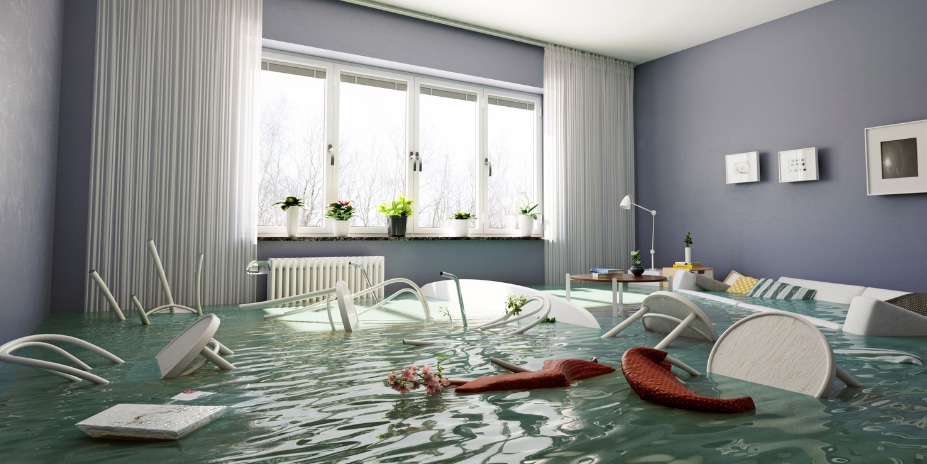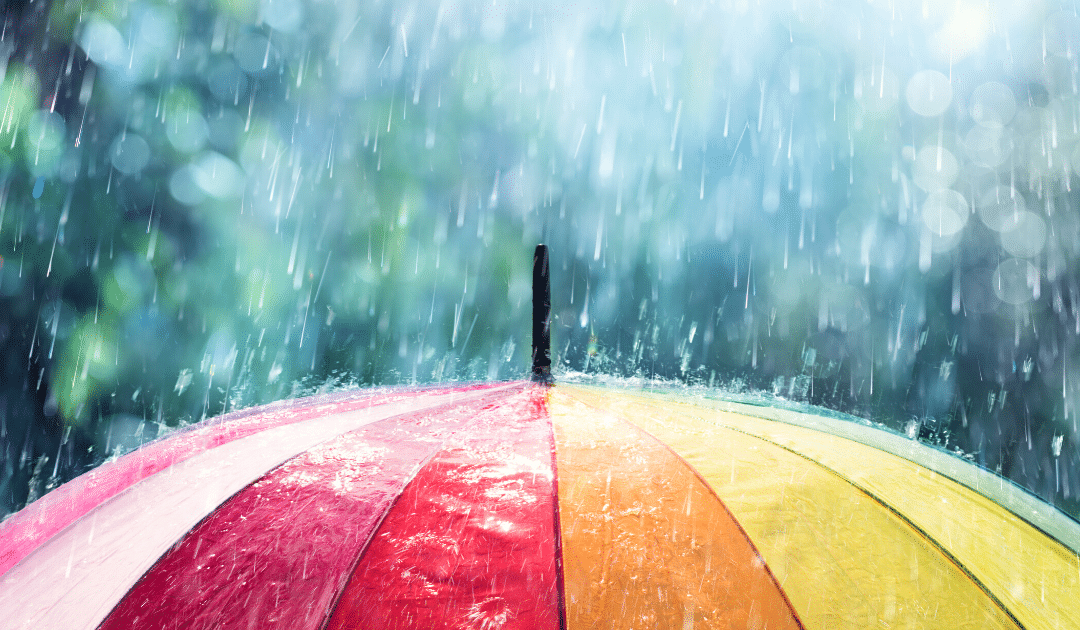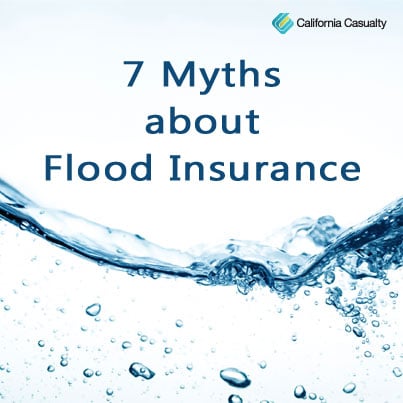
by California Casualty | Calcas Connection, Finances, Homeowners Insurance Info, Safety |
Flooding is one of the costliest natural disasters in the United States, with the potential to impact millions of homes and communities. While FEMA and other agencies provide flood maps to help homeowners understand their risk levels, many of these maps are outdated, leading to a false sense of security for people who live in areas not designated as high-risk. Floods, however, aren’t limited to high-risk zones; even areas classified as low-risk are vulnerable under certain conditions. For these reasons, it’s vital to consider flood insurance no matter where you live.
Outdated Flood Maps and the Misleading Risk of Flooding
Flood maps are designed to inform residents and local authorities about the likelihood of flooding based on historical data, topography, and other factors. FEMA’s maps, for instance, divide areas into high, moderate, and low-risk zones, which guide flood insurance requirements and building regulations. However, some flood maps haven’t been updated for years and many don’t accurately reflect changes in land use, climate patterns, or new developments, which can significantly alter flood risks.
Changes to flood risks include:
- Urban Expansion: As cities and towns expand, natural land is replaced with pavement and buildings, which leads to increased runoff and reduced soil absorption. Areas previously considered low risk might become more prone to flooding as water has fewer places to go.
- Climate Change and Extreme Weather: Flood maps are based on historical data and often don’t account for the increasing frequency and intensity of extreme weather events that can result in both droughts and unprecedented rainstorms, often within the same year. In areas affected by wildfires where vegetation loss reduces soil stability, runoff increases. Outdated flood maps may fail to reflect these climate driven impacts, leading many property owners to underestimate their exposure.
- Erosion and Infrastructure Changes: Natural factors like erosion, as well as human-made infrastructure changes, can impact flood patterns over time. Rivers shift, drainage systems get updated, and dams or levees are added or removed—all of which can alter the flow of water and increase the risk in areas thought to be safe.
The Risks of Flooding in “Low-Risk” Areas
Approximately 40% of flood insurance claims in the U.S. come from properties located outside designated high-risk flood zones. Many low-risk or moderate-risk areas are prone to what is known as “flash flooding” from sudden, heavy rainfall or overflowing drainage systems that cannot keep up. Recent flooding incidents in areas far from coastlines or rivers illustrate how floodwaters can impact anyone, anywhere.
Causes of flooding in low-risk areas include:
- Heavy Rainfall: Even a few hours of intense rain can lead to flash flooding, especially in areas with inadequate drainage or impermeable surfaces like concrete. Low-risk flood zones can still see significant flooding from strong, localized storms.
- Snow Melt and Frozen Ground: In colder climates, rapid snowmelt or rain on frozen ground can lead to significant runoff, overwhelming waterways and drainage systems even in low-risk flood areas.
- Infrastructure Failures: Overflowing sewer systems, clogged drainage, or burst water mains can also lead to localized flooding, impacting areas that flood maps don’t highlight.
Because low-risk zones are not usually required to have flood insurance, many homeowners assume they’re safe. Unfortunately, without a flood-specific insurance policy, any flood damage may need to be covered out-of-pocket, which can lead to devastating financial loss.
Why Flood Insurance Is Essential, Even Outside High-Risk Areas
Given the limitations of flood maps and the growing risk of unexpected flooding, flood insurance is a wise investment for all homeowners. Standard homeowner insurance policies typically do not cover flood damage, so without flood insurance, homeowners face the full financial impact of repairs, replacement of belongings, and sometimes even temporary housing costs.
Here are several reasons to consider flood insurance regardless of risk classification:
- Affordable Coverage in Low-Risk Areas: In areas considered low- to moderate-risk, flood insurance premiums are often lower than in high-risk zones. This makes it possible to secure essential coverage without significant cost.
- Financial Protection: The cost of even minor flooding can add up quickly. Carpets, drywall, and flooring may need to be replaced, and waterlogged appliances or furniture might be beyond repair. Flood insurance helps cover these costs, sparing you from paying out of pocket.
- Home Value and Mortgage Requirements: While most mortgage lenders don’t require flood insurance in low-risk areas, opting for coverage can help protect your home’s value by making it easier to get it back to pre-flood condition.
- Adaptability to Climate Change: As weather patterns continue to change, so does the risk of flooding. Flood insurance ensures that you are protected no matter what nature brings, providing adaptable protection in an unpredictable environment.
Taking a Proactive Approach to Flood Protection
Beyond purchasing flood insurance, you can take steps to protect your property from potential flooding:
- Upgrade Drainage Systems: Make sure gutters and downspouts are clear and well-maintained to help direct rainwater away from your home.
- Install Sump Pumps or Flood Barriers: For homes with basements, sump pumps can be a lifesaver in the event of heavy rain. Flood barriers can also be installed around doors and windows for additional protection.
- Regular Property Checks: Monitoring your property for pooling water and ensuring nearby storm drains are clear can help reduce localized flooding.
Outdated flood maps and assumptions about risk can lead to costly surprises for homeowners. While flood insurance may seem unnecessary in low-risk areas, recent floods across unexpected locations show that no one is entirely safe from flood risks. By securing flood insurance and taking proactive protective measures, you can shield your finances and assets from unforeseen disasters – and be prepared no matter what the flood maps say.
If you’re interested in learning more or getting a flood insurance quote, the California Casualty Agency Services team can help. Call 1.877.652.2638 or visit https://www.calcas.com/flood-insurance.

by California Casualty | Calcas Connection, Consider This, Safety |
It’s no secret that spring storms can bring heavy rainfall in short amounts of time. This not only can cause rivers and lakes to rise outside their banks, but it can also cause flooding in city streets and near homes.
Contrary to what many may think is covered under their insurance policy, a Home or Renter’s insurance policy will not cover a flood. If you live in an area prone to flooding, you need to also purchase flood insurance. Floods are one of the most dangerous disasters in the United States, and if you don’t purchase flood insurance, they can cost you big time. The National Flood Insurance Program (NFIP) estimates that just one inch of water in a 2,000 square foot house will result in $23,000 in damage.
Flood season has arrived. Here are five reasons you need flood insurance now:
1. It’s not just for homeowners and businesses.
Flood coverage is available for renters. Condo owners can also purchase it. It will cover damage to your possessions from a flood.
2. Flooding is not covered under your standard policy.
Homeowners and renters need to purchase separate flood policies. Umbrella insurance does not usually cover flooding, either.
3. Floods aren’t limited to flood plains.
Every state has experienced flooding, and it can happen anywhere. The NFIP estimates that 25 percent of flood claims come from areas outside of high-risk flood zones.
4. Flood insurance doesn’t take effect immediately.
There is a 30-day waiting period from the date you purchase the insurance until you are covered, in most cases.
5. It’s often not as expensive as you think.
The average policy costs about $700 per year. The higher your risk, the higher your premium. Costs do vary depending on your flood risk and the year and type of construction. Keep in mind, the average residential flood claim amounted to more than $38,000.
Don’t delay, there is a 30-day waiting period before flood coverage goes into effect. Call a California Casualty advisor today at 1.877.652.2638 to make sure you’re covered. Or, contact our Agency Services department at agencyservices@calcas.com.
This article is furnished by California Casualty, providing auto and home insurance to educators, law enforcement officers, firefighters, and nurses. Get a quote at 1.866.704.8614 or www.calcas.com.
by California Casualty | Homeowners Insurance Info |

If you live in a flood prone area, you should have flood insurance. It seems like common sense but many of us still don’t get it. As rivers crested to new heights and raging waters destroyed homes in Central and Southern Texas this spring, the Insurance Council of Texas fears that less than half of those with damage purchased a flood policy. Many thousands affected by record flooding in South Carolina may also be without flood insurance; state insurance companies estimate that only 10% of residents purchased flood protection.
Here are some reasons why people don’t buy flood insurance:
- They think their homeowners or renters insurance covers flooding
- They think the government will help them
- They think it’s too expensive
- They didn’t know it was available
Floods are the number one disaster in the United States and the National Flood Insurance Program estimates that just three inches of water in a 2,000 square foot house will result in $23,000 in damage.
With that in mind, let’s soak up seven myths that might be floating around about flood insurance.
- Flooding is covered under most homeowners insurance.
It is not. Homeowners and renters need to purchase separate flood insurance protection. Umbrella insurance does not usually cover flooding.
- I don’t live in a flood prone area so I don’t need it.
Every state in the union has experienced flooding and it can happen anywhere. The National Flood Insurance Program estimates that 25 percent of flood claims come from areas outside of high-risk flood zones.
- The Federal Government will help pay for flood damage.
Federal disaster assistance is only available when the president formally declares a disaster. The aid comes as low interest loans, not compensation for your damage.
- Flood insurance is only for homeowners and businesses.
Flood insurance is available to renters. It is also available to condo owners and renters. It will cover damage to your possessions from a flood.
- Flood Insurance is expensive.
The average policy costs about $700 per year: the higher your risk, the higher your premium. Keep in mind the average residential flood claim amounted to more than $38,000.
- I can get flood insurance coverage immediately.
In most cases there is a 30 day waiting period from the date you purchase the insurance before it goes into effect.
- I can shop around for the best flood insurance deal.
While you can purchase flood insurance from numerous companies, the price is set by the federal government and doesn’t vary. Rates do vary depending on your flood risk and the year and type of construction.
If you have experienced flood damage, here are some things you should be doing:
- Make sure the building is safe to enter – mud and water may contain dangerous chemicals, bacteria or poisonous snakes and there could be a risk from electrocution
- Secure the property from further damage or theft with plywood, tarps or plastic
- Remove branches and other debris
- Before cleanup, take photos or videos of all the damage
- Throw out water damaged food including canned goods
- Keep receipts for any items you buy to make temporary repairs and for living expenses, they may be covered if your loss is insured or can be used for tax purposes if the loss is not covered
- Contact your insurance company – flooding and other water damage to your vehicle is covered if you have comprehensive auto insurance
For more information about what is and is not covered with flood insurance, visit https://www.floodsmart.gov/floodsmart/pages/residential_coverage/whats_covered.jsp.
California Casualty can help keep you above water with flood insurance. Find out more today at 877.652.2638 or visit www.calcas.com/flood-insurance. Make sure your property is fully protected from wind, fire, lightning, hail or falling trees with a policy review by calling an advisor today at 1.800.800.9410 or visiting www.calcas.com.
Resources for this article:
https://www.floodsmart.gov.
https://www.ready.gov/floods
https://www.thestate.com/news/local/article37740939.html
by California Casualty | Auto Insurance Info, Homeowners Insurance Info |
In the wake of Hurricane Sandy, many homeowners are dealing with Flooding damages.
We wanted to provide you with some basic Flood Insurance information* so you can be sure you are fully protected:
- Standard homeowners insurance does NOT cover flooding: Your homeowners insurance policy will not cover flooding damage. Only Flood Insurance covers this kind of damage. To learn more about Flood Insurance through California Casualty, click here or scroll down to read more.
- Flood damages are expensive: Just two inches of water could result in more than $7,000 in damages. The higher the water, the higher the costs.
- New Policies take 30 days to kick in: If your home is at any risk of flooding, protect it now. Flood insurance policies take 30 days to take effect.
- Flood insurance offers two types of protection: Flood insurance protects your building and the contents inside of the building. Neither type protects the land they occupy.
- Building Coverage includes:
- The insured building and its foundation
- The electrical and plumbing systems
- Central air conditioning equipment, furnaces, and water heaters
- Refrigerators, cooking stoves, and built-in appliances such as dishwashers
- Permanently installed carpeting over unfinished floors
- Contents coverage includes:
- Clothing, furniture, and electronic equipment
- Curtains
- Portable and window air conditioner units
- Portable microwaves and dishwashers
- Carpeting that is not already included in property coverage
- Clothing washers and dryers
Securing Flood Insurance through California Casualty:
We provide flood insurance through the National Flood Insurance Program to offer you the best rates and service. It was created by Congress in 1968 to help property owners protect themselves financially against flood damages. To learn about the program, click here.
*These represent typical coverages, you should speak with an agent to verify what is and is not covered
by California Casualty | Homeowners Insurance Info |
This has been a difficult spring in terms of natural disasters – from devastating tornadoes to a large number of hail storms. Currently, we’re watching towns in the south being submerged under water, and rivers in flood stages that haven’t been seen in recent history.
Our hearts go out these families, and you can rest assured that we are doing everything we can to help our customers who have been affected by all of these disasters. For many, seeing the flooding (and with hurricane season bearing down on us) begs the question – “Am I covered if this happens to me?” This press release just came across my desk, and hopefully it will answer some of those questions.
CHICAGO—With hurricane season starting on June 1st, the Property Casualty Insurers Association of America (PCI) urges homeowners, business owners and renters who do not currently have flood insurance to buy it right away.
“Many insurance consumers do not realize that their standard homeowners policy does not cover flooding, and that flood insurance must be purchased separately,” said Don Griffin, PCI’s vice president, personal lines. “Flood insurance is sold through agents who sell policies on behalf of the National Flood Insurance Program (NFIP). If you have only a standard homeowners policy and suffer flooding from a hurricane, the flood damage will not be covered under that policy, so it is crucial to have flood insurance. Because NFIP policies don’t take effect for 30 days, the sooner people can buy flood insurance, the better.”
While having flood insurance in place is important in coastal areas, recent heavy rains have brought flooding to much of the nation’s heartland as well. Unfortunately, according to the NFIP, more than 50 percent of properties in high-risk areas remain unprotected by flood insurance, and in the northeast and Midwest, coverage rates are significantly lower. Even in coastal areas that live under constant threat of hurricanes or tropical storms, many homeowners or renters do not have this crucial coverage.
According to the NFIP, floods are the number-one natural disaster in the United States, and 75 percent of all federally declared disasters over the past five years have involved flooding. There is a 26 percent chance that a home will suffer flooding over the course of a 30-year mortgage, and U.S. flood losses have averaged $2.4 billion per year over the last decade.
“In any part of the country where flooding is a possibility, property owners and renters should absolutely make sure to protect themselves and their belongings by purchasing flood insurance,” Griffin said.
Individuals who currently have homeowners or renters insurance should talk to their agents to see if their insurers sell flood policies. They can also locate agents who sell flood policies through the agent locator on the NFIP website.



